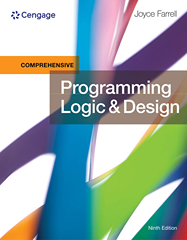Programming Logic and Design Introductory
Material type: TextLanguage: English Publication details: Australia : Cengage Learning , c2018Edition: 9thDescription: xv, 352 p. : illISBN:
TextLanguage: English Publication details: Australia : Cengage Learning , c2018Edition: 9thDescription: xv, 352 p. : illISBN: - 9781337109635
- 005.115 FAR
| Item type | Current library | Shelving location | Call number | Copy number | Status | Date due | Barcode |
|---|---|---|---|---|---|---|---|
 Lending Collection
Lending Collection
|
Circulation Section | Circulation Section | 005.115 FAR | 2023-24 | Available | 98490 |
AUTHOR
Joyce Farrell
Joyce Farrell has authored several popular programming textbooks, including books on Programming Logic and Design, Java, C#, and C++. Her books are recognized for their clear, direct writing style and effective presentation. A well-respected instructor, Ms. Farrell has taught Computer Information Systems at Harper College in Palatine, Illinois; the University of Wisconsin-Stevens Point; and McHenry County College in Crystal Lake, Illinois.
SUMMARY
Teach the fundamental principles of developing structured program logic with Farrell’s PROGRAMMING LOGIC AND DESIGN: INTRODUCTORY, 9E. A popular choice for foundational programming, this proven text takes a unique, language-independent approach with a distinct emphasis on modern conventions. Noted for its clear writing, the book eliminates highly technical jargon while introducing universal programming concepts and ensuring strong programming and logical thinking. Frequent side notes and Quick Reference boxes clarify important programming concepts while chapter objectives, concise chapter summaries, and key terms guide learning. End-of-chapter practice provides multiple-choice review, programming and gaming exercises, debugging exercises, and maintenance exercises that challenge students to improve working logic.
